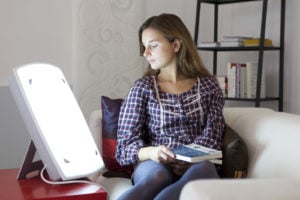When you buy through our links, we may earn a commission. Products or services may be offered by an affiliated entity. Learn more.
Can’t Sleep? 8 Techniques You Can Do
Nearly everyone is familiar with that seemingly inescapable feeling of being awake in the middle of the night, with everything quiet – except for your brain. We offer tested tips and relaxation exercises to calm your mind and help you get the sleep you need.
1. Controlled Breathing
Slow, deep breathing can bring your body into a state of relaxation.
- Place one hand on your stomach and the other on your chest.
- Inhale slowly, directing your breath deep into your belly. The hand on your stomach should gradually rise, while the one on your chest should have little to no movement.
- Exhale gently, allowing the hand on your stomach to gradually fall.
Repeat this exercise several times, until you feel ready to sleep or to transition into another relaxation ritual.
2. Body Scan Meditation
Many people use meditation practices to invite calm and to promote mental and physical well-being. Body scans are a type of meditation that involve directing attention to different areas of the body without judging the sensations that arise.
- Lie in bed face up with your hands at your side.
- Spend a few moments practicing controlled breathing.
- Direct your attention to sensations in your feet without labeling them as good or bad.
- Breathe deeply and imagine the breath traveling all the way to your feet. As you exhale, let your feet dissolve from your awareness, and direct your attention to your ankles and calves.
- Move your attention progressively upward until you reach the head.
- Finish the practice by becoming aware of your body as a whole and breathing deeply.
3. Progressive Muscle Relaxation
Progressive muscle relaxation (PMR) is a technique that involves deliberately tensing and relaxing particular muscle groups, which can help you recognize and release tension in the body.
- Sit or lie in a comfortable position and become aware of your breath.
- As you slowly breathe in, clench your fists, noticing sensations that accompany tightening your muscles.
- Gently exhale, relaxing your hands. Notice tension draining out of your muscles.
- Repeat this process, tensing as you inhale and releasing as you exhale, for muscle groups throughout your body.
4. Imagery
Imagery—also sometimes called visualization—is a technique that involves imagining peaceful or comforting scenes that encourage the body to relax. You can practice visualization on your own or you can access guided imagery exercises online or through apps.
- Find a comfortable position and close your eyes. Practice controlled breathing for a few moments.
- Imagine yourself in a scene that feels calming and relaxing, such as on a beach.
- Picture as many pleasant details as you can, taking note of feelings of relaxation in your body.
5. The Military Method
Need to fall asleep anywhere, anytime? The military sleep method might be perfect for you. This method was designed to help service members fall asleep in tense or difficult situations by teaching them to quickly relax their body and mind.
- Relax our face, moving from your forehead to your jaw.
- Release any tension in your shoulders and arms, allowing them to rest at your sides.
- Take a slow, deep breath and then gradually exhale.
- Relax your legs, beginning with the hips and thighs and working your way to the tips of your toes.
- With your eyes closed, imagine a peaceful scene. If you get distracted, repeat a simple phrase in your mind, like “be still.”
6. Dr. Andrew Weil’s 4-7-8 Breathing
The 4-7-8 breathing technique was created to calm the nervous system and promote relaxation. This method of breathing control involves establishing a pattern of inhaling, holding breath, and exhaling in a specific ratio.
- Close your eyes and place the tip of your tongue on the roof of your mouth, just behind your teeth. Keep your tongue in this position for the whole exercise.
- Close your mouth and breathe in through your nose as you count to four in your mind.
- Hold your breath, and count to seven.
- Open your mouth and exhale as you count to eight. Allow the breath to make a whooshing sound as it leaves your body.
- Repeat steps two through four three more times, making sure that your breathing pattern follows the 4-7-8 ratio.
7. Play a Word Game
Playing a word game can help you relax by keeping stressful thoughts at bay. Games that engage you in repetitive, monotonous tasks are also likely to make you feel sleepy. A cognitive scientist named Luc Beaudoin developed the following word game to help people sleep.
- Pick a neutral word of five or more letters. Choose a word without repeating letters, such as dream.
- Think of as many words as you can that begin with the first letter of your chosen word. For the word dream, you might list the words dog, duck, donut, or dimples.
- Visualize each word you come up with.
- Repeat this process for each letter in the word.
- If you feel sleepy before finishing the game, allow yourself to fall asleep.
8. Autogenic Training
Autogenic training is a relaxation technique that uses self-hypnosis to promote sleep. It involves repeating phrases that focus awareness on relaxing sensations in different areas of the body.
To practice, lie in bed with your eyes closed and recite sets of six to 10 phrases for each of the following sensations:
- “Warmth in the arms and legs”
- “Heaviness in the arms and legs”
- “A slow, steady heartbeat”
- “Slow, calm, regular breathing”
- “Softness and warmth in the belly”
- “A cool forehead”
With each progressive set, retain some phrases from the previous sets and introduce new ones. Here are example first and final sets.
| First set: | Final set: |
|---|---|
| My left foot is warm. (x 3) My right foot is warm. (x 3) Both of my legs are warm. (x 3) My feet and legs are warm. (x 3) My right hand is warm. (x 3) My left hand is warm. (x 3) Both of my arms are warm. (x 3) My hands and arms are warm. (x 3) | My arms and legs are warm and heavy. (x3) My heartbeat is slow and steady. (x3) My breathing is calm and regular. (x3) My belly is warm and relaxed. (x3) My forehead is cool. (x3) My body is at peace. (x3) |
The Big Picture: Proactive Tips to Sleep Better
Practicing good sleep hygiene—the habits and behaviors that support healthy sleep—is a great way to make sure you get the most out of any relaxation technique.
- Get at least 30 minutes of natural light early in the day
- Maintain a consistent sleep schedule – even on weekends
- Optimize your bedroom environment for sleep
- Avoid caffeine at least eight hours before bed
- Don’t drink alcohol at least four hours before bed
References
6 Sources
-
Mirgain, S. (2016 September). A Body Scan Script. Office of Patient Centered Care & Cultural Transformation. U.S. Department of Veterans Affairs., Retrieved November 7, 2023, from
https://www.va.gov/WHOLEHEALTHLIBRARY/docs/Script-Body-Scan.pdf -
Mirgain, S. & Singles, J. (2023). Progressive Muscle Relaxation. Office of Patient Centered Care & Cultural Transformation. U.S. Department of Veterans Affairs., Retrieved November 8, 2023, from
https://www.va.gov/WHOLEHEALTHLIBRARY/docs/Progressive-Muscle-Relaxation.pdf -
U.S. Department of Veterans Affairs. (2015, September). Relaxation Exercise: Visualization. Veterans Employment Toolkit., Retrieved November 8, 2023, from
https://www.va.gov/vetsinworkplace/docs/em_eap_exercise_visualizing.asp -
Weil, A. (2022, February). Three Breathing Exercises and Techniques. DrWeil., Retrieved November 9, 2023, from
https://www.drweil.com/health-wellness/body-mind-spirit/stress-anxiety/breathing-three-exercises/ -
CBC News. (2017, May). B.C. professor’s sleep trick gets attention from Oprah, Forbes, Guardian., Retrieved November 9, 2023, from
https://www.cbc.ca/news/canada/british-columbia/sfu-sleep-trick-luc-beaudoin-1.4092294 -
Ilkevitch, A. (2020, June). Autogenic Training. Office of Patient Centered Care & Cultural Transformation. U.S. Department of Veterans Affairs., Retrieved November 9, 2023, from
https://www.va.gov/WHOLEHEALTH/veteran-handouts/docs/AutogenicTraining-508Final-9-5-2018.pdf
























